Strategic Human Resource Management: A Detailed Analysis
VerifiedAdded on 2020/03/28
|16
|4241
|257
Essay
AI Summary
This essay provides a comprehensive overview of Strategic Human Resource Management (SHRM), emphasizing its crucial role in aligning HR functions with overall business strategy to achieve an organization's vision. The essay begins by defining SHRM and discussing its theoretical underpinnings, including various models like the Hard and Soft models, the Harvard model, and the Guest model, highlighting their contributions to understanding HRM practices. It then delves into the practical aspects of SHRM, examining how HR departments contribute to strategic planning, recruitment, employee orientation, training, and development, and employee relations. The essay emphasizes the importance of employee training, performance appraisal, and the creation of a positive work environment, providing real-world examples like Morrisons Retail. Furthermore, it explores the SHRM competency model, strategic HR planning, and the significance of fair valuation of human capital. By examining these elements, the essay illustrates how effective SHRM can lead to enhanced organizational performance, competitive advantage, and the successful achievement of long-term business goals. This analysis underscores the strategic importance of HRM in modern organizations, providing insights into how HR can be a driving force in achieving organizational objectives.
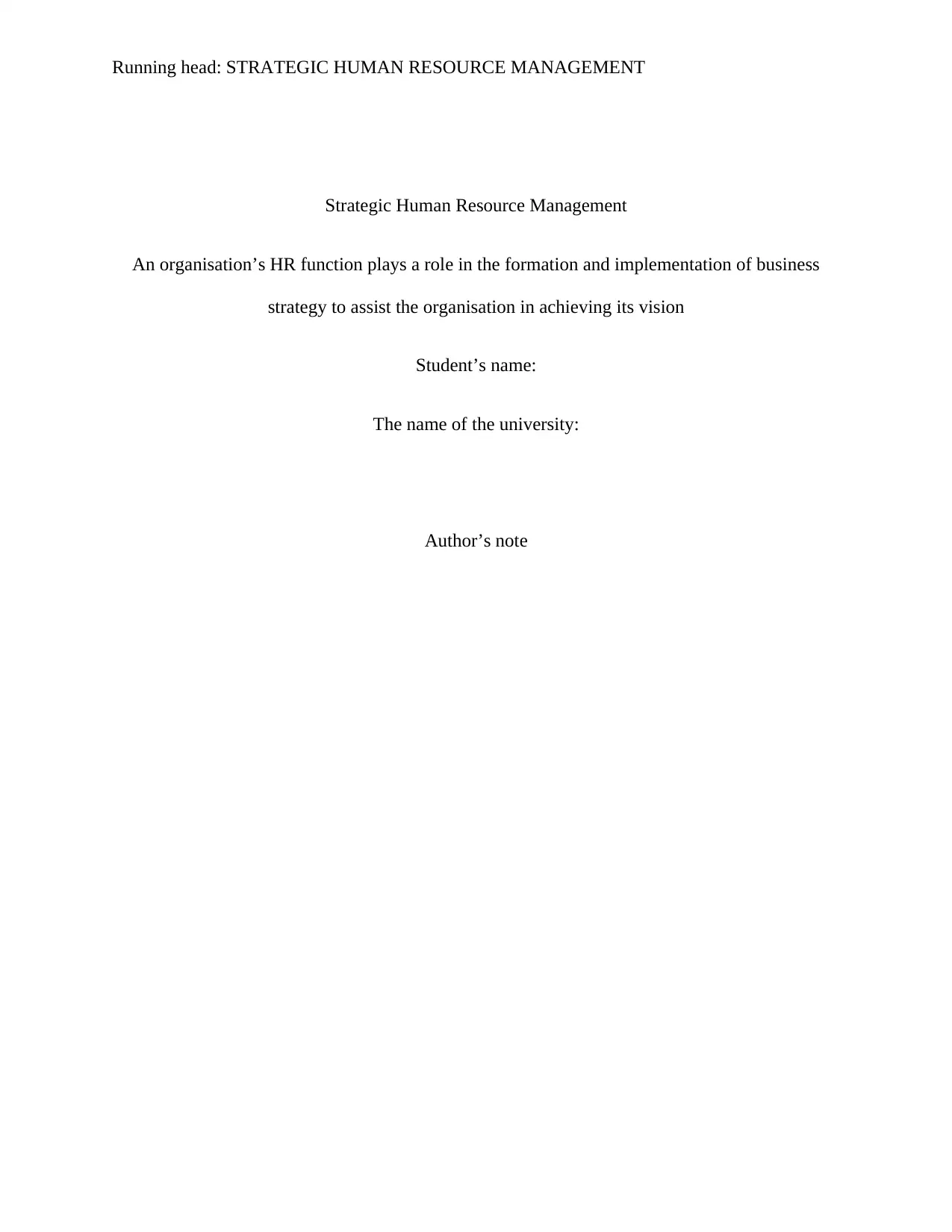
Running head: STRATEGIC HUMAN RESOURCE MANAGEMENT
Strategic Human Resource Management
An organisation’s HR function plays a role in the formation and implementation of business
strategy to assist the organisation in achieving its vision
Student’s name:
The name of the university:
Author’s note
Strategic Human Resource Management
An organisation’s HR function plays a role in the formation and implementation of business
strategy to assist the organisation in achieving its vision
Student’s name:
The name of the university:
Author’s note
Paraphrase This Document
Need a fresh take? Get an instant paraphrase of this document with our AI Paraphraser
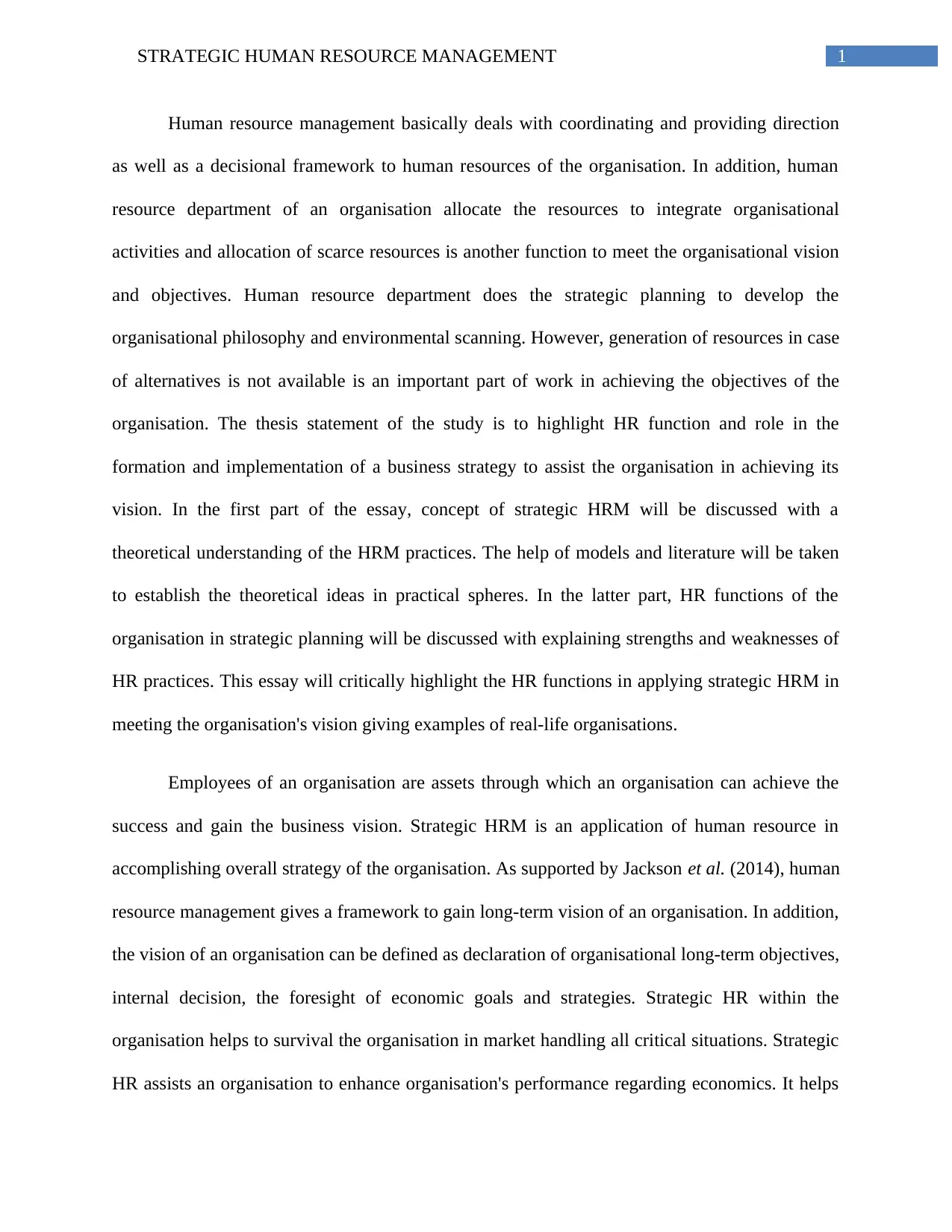
1STRATEGIC HUMAN RESOURCE MANAGEMENT
Human resource management basically deals with coordinating and providing direction
as well as a decisional framework to human resources of the organisation. In addition, human
resource department of an organisation allocate the resources to integrate organisational
activities and allocation of scarce resources is another function to meet the organisational vision
and objectives. Human resource department does the strategic planning to develop the
organisational philosophy and environmental scanning. However, generation of resources in case
of alternatives is not available is an important part of work in achieving the objectives of the
organisation. The thesis statement of the study is to highlight HR function and role in the
formation and implementation of a business strategy to assist the organisation in achieving its
vision. In the first part of the essay, concept of strategic HRM will be discussed with a
theoretical understanding of the HRM practices. The help of models and literature will be taken
to establish the theoretical ideas in practical spheres. In the latter part, HR functions of the
organisation in strategic planning will be discussed with explaining strengths and weaknesses of
HR practices. This essay will critically highlight the HR functions in applying strategic HRM in
meeting the organisation's vision giving examples of real-life organisations.
Employees of an organisation are assets through which an organisation can achieve the
success and gain the business vision. Strategic HRM is an application of human resource in
accomplishing overall strategy of the organisation. As supported by Jackson et al. (2014), human
resource management gives a framework to gain long-term vision of an organisation. In addition,
the vision of an organisation can be defined as declaration of organisational long-term objectives,
internal decision, the foresight of economic goals and strategies. Strategic HR within the
organisation helps to survival the organisation in market handling all critical situations. Strategic
HR assists an organisation to enhance organisation's performance regarding economics. It helps
Human resource management basically deals with coordinating and providing direction
as well as a decisional framework to human resources of the organisation. In addition, human
resource department of an organisation allocate the resources to integrate organisational
activities and allocation of scarce resources is another function to meet the organisational vision
and objectives. Human resource department does the strategic planning to develop the
organisational philosophy and environmental scanning. However, generation of resources in case
of alternatives is not available is an important part of work in achieving the objectives of the
organisation. The thesis statement of the study is to highlight HR function and role in the
formation and implementation of a business strategy to assist the organisation in achieving its
vision. In the first part of the essay, concept of strategic HRM will be discussed with a
theoretical understanding of the HRM practices. The help of models and literature will be taken
to establish the theoretical ideas in practical spheres. In the latter part, HR functions of the
organisation in strategic planning will be discussed with explaining strengths and weaknesses of
HR practices. This essay will critically highlight the HR functions in applying strategic HRM in
meeting the organisation's vision giving examples of real-life organisations.
Employees of an organisation are assets through which an organisation can achieve the
success and gain the business vision. Strategic HRM is an application of human resource in
accomplishing overall strategy of the organisation. As supported by Jackson et al. (2014), human
resource management gives a framework to gain long-term vision of an organisation. In addition,
the vision of an organisation can be defined as declaration of organisational long-term objectives,
internal decision, the foresight of economic goals and strategies. Strategic HR within the
organisation helps to survival the organisation in market handling all critical situations. Strategic
HR assists an organisation to enhance organisation's performance regarding economics. It helps
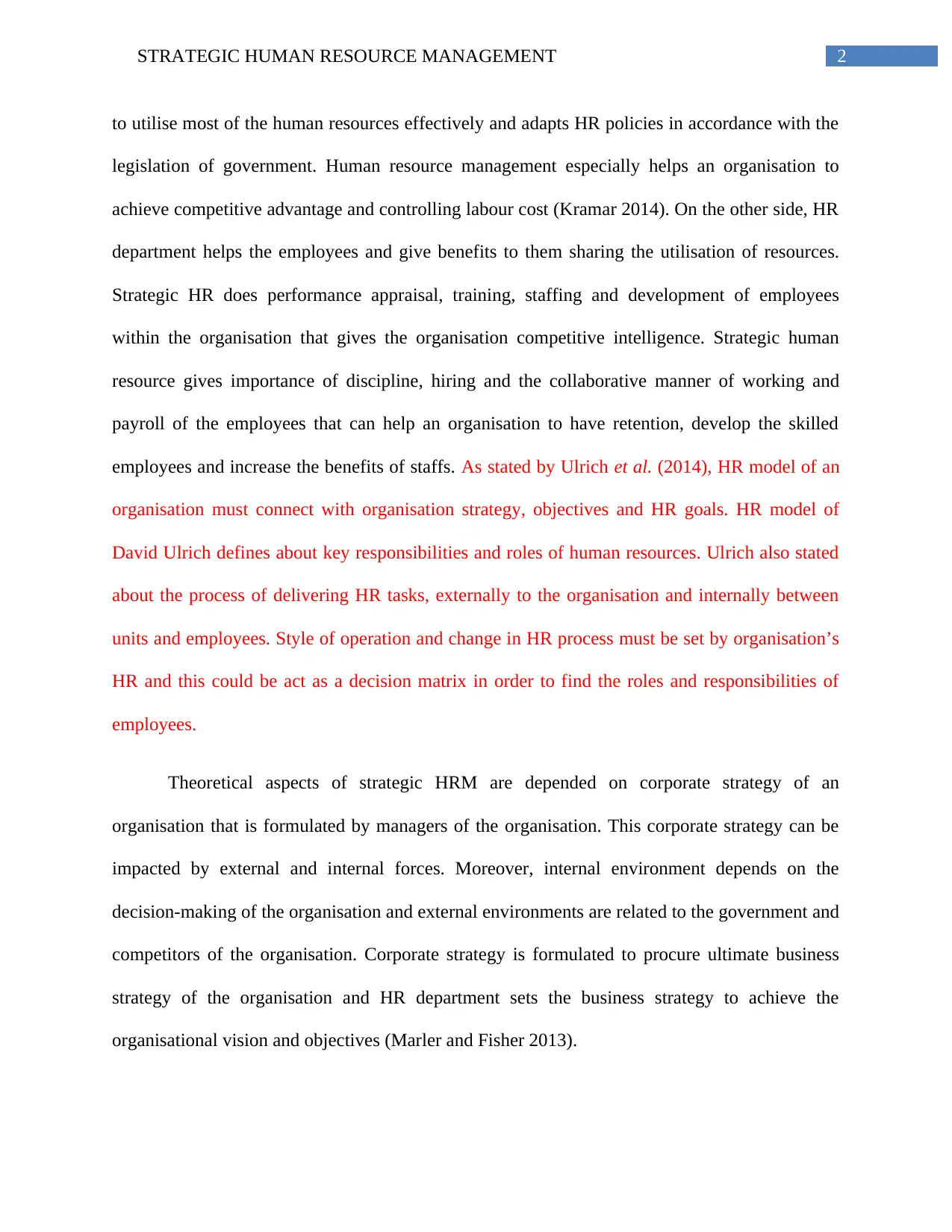
2STRATEGIC HUMAN RESOURCE MANAGEMENT
to utilise most of the human resources effectively and adapts HR policies in accordance with the
legislation of government. Human resource management especially helps an organisation to
achieve competitive advantage and controlling labour cost (Kramar 2014). On the other side, HR
department helps the employees and give benefits to them sharing the utilisation of resources.
Strategic HR does performance appraisal, training, staffing and development of employees
within the organisation that gives the organisation competitive intelligence. Strategic human
resource gives importance of discipline, hiring and the collaborative manner of working and
payroll of the employees that can help an organisation to have retention, develop the skilled
employees and increase the benefits of staffs. As stated by Ulrich et al. (2014), HR model of an
organisation must connect with organisation strategy, objectives and HR goals. HR model of
David Ulrich defines about key responsibilities and roles of human resources. Ulrich also stated
about the process of delivering HR tasks, externally to the organisation and internally between
units and employees. Style of operation and change in HR process must be set by organisation’s
HR and this could be act as a decision matrix in order to find the roles and responsibilities of
employees.
Theoretical aspects of strategic HRM are depended on corporate strategy of an
organisation that is formulated by managers of the organisation. This corporate strategy can be
impacted by external and internal forces. Moreover, internal environment depends on the
decision-making of the organisation and external environments are related to the government and
competitors of the organisation. Corporate strategy is formulated to procure ultimate business
strategy of the organisation and HR department sets the business strategy to achieve the
organisational vision and objectives (Marler and Fisher 2013).
to utilise most of the human resources effectively and adapts HR policies in accordance with the
legislation of government. Human resource management especially helps an organisation to
achieve competitive advantage and controlling labour cost (Kramar 2014). On the other side, HR
department helps the employees and give benefits to them sharing the utilisation of resources.
Strategic HR does performance appraisal, training, staffing and development of employees
within the organisation that gives the organisation competitive intelligence. Strategic human
resource gives importance of discipline, hiring and the collaborative manner of working and
payroll of the employees that can help an organisation to have retention, develop the skilled
employees and increase the benefits of staffs. As stated by Ulrich et al. (2014), HR model of an
organisation must connect with organisation strategy, objectives and HR goals. HR model of
David Ulrich defines about key responsibilities and roles of human resources. Ulrich also stated
about the process of delivering HR tasks, externally to the organisation and internally between
units and employees. Style of operation and change in HR process must be set by organisation’s
HR and this could be act as a decision matrix in order to find the roles and responsibilities of
employees.
Theoretical aspects of strategic HRM are depended on corporate strategy of an
organisation that is formulated by managers of the organisation. This corporate strategy can be
impacted by external and internal forces. Moreover, internal environment depends on the
decision-making of the organisation and external environments are related to the government and
competitors of the organisation. Corporate strategy is formulated to procure ultimate business
strategy of the organisation and HR department sets the business strategy to achieve the
organisational vision and objectives (Marler and Fisher 2013).
⊘ This is a preview!⊘
Do you want full access?
Subscribe today to unlock all pages.

Trusted by 1+ million students worldwide
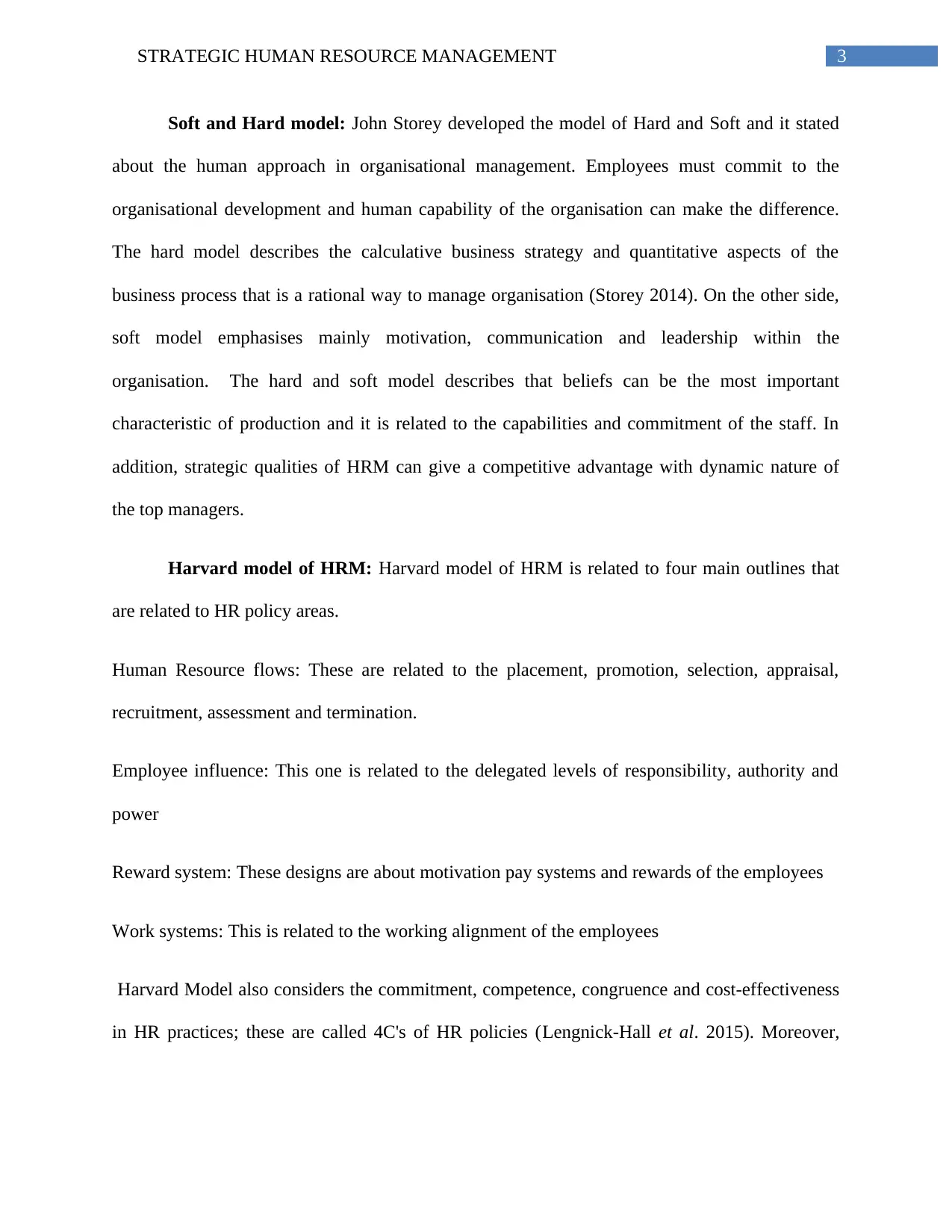
3STRATEGIC HUMAN RESOURCE MANAGEMENT
Soft and Hard model: John Storey developed the model of Hard and Soft and it stated
about the human approach in organisational management. Employees must commit to the
organisational development and human capability of the organisation can make the difference.
The hard model describes the calculative business strategy and quantitative aspects of the
business process that is a rational way to manage organisation (Storey 2014). On the other side,
soft model emphasises mainly motivation, communication and leadership within the
organisation. The hard and soft model describes that beliefs can be the most important
characteristic of production and it is related to the capabilities and commitment of the staff. In
addition, strategic qualities of HRM can give a competitive advantage with dynamic nature of
the top managers.
Harvard model of HRM: Harvard model of HRM is related to four main outlines that
are related to HR policy areas.
Human Resource flows: These are related to the placement, promotion, selection, appraisal,
recruitment, assessment and termination.
Employee influence: This one is related to the delegated levels of responsibility, authority and
power
Reward system: These designs are about motivation pay systems and rewards of the employees
Work systems: This is related to the working alignment of the employees
Harvard Model also considers the commitment, competence, congruence and cost-effectiveness
in HR practices; these are called 4C's of HR policies (Lengnick-Hall et al. 2015). Moreover,
Soft and Hard model: John Storey developed the model of Hard and Soft and it stated
about the human approach in organisational management. Employees must commit to the
organisational development and human capability of the organisation can make the difference.
The hard model describes the calculative business strategy and quantitative aspects of the
business process that is a rational way to manage organisation (Storey 2014). On the other side,
soft model emphasises mainly motivation, communication and leadership within the
organisation. The hard and soft model describes that beliefs can be the most important
characteristic of production and it is related to the capabilities and commitment of the staff. In
addition, strategic qualities of HRM can give a competitive advantage with dynamic nature of
the top managers.
Harvard model of HRM: Harvard model of HRM is related to four main outlines that
are related to HR policy areas.
Human Resource flows: These are related to the placement, promotion, selection, appraisal,
recruitment, assessment and termination.
Employee influence: This one is related to the delegated levels of responsibility, authority and
power
Reward system: These designs are about motivation pay systems and rewards of the employees
Work systems: This is related to the working alignment of the employees
Harvard Model also considers the commitment, competence, congruence and cost-effectiveness
in HR practices; these are called 4C's of HR policies (Lengnick-Hall et al. 2015). Moreover,
Paraphrase This Document
Need a fresh take? Get an instant paraphrase of this document with our AI Paraphraser
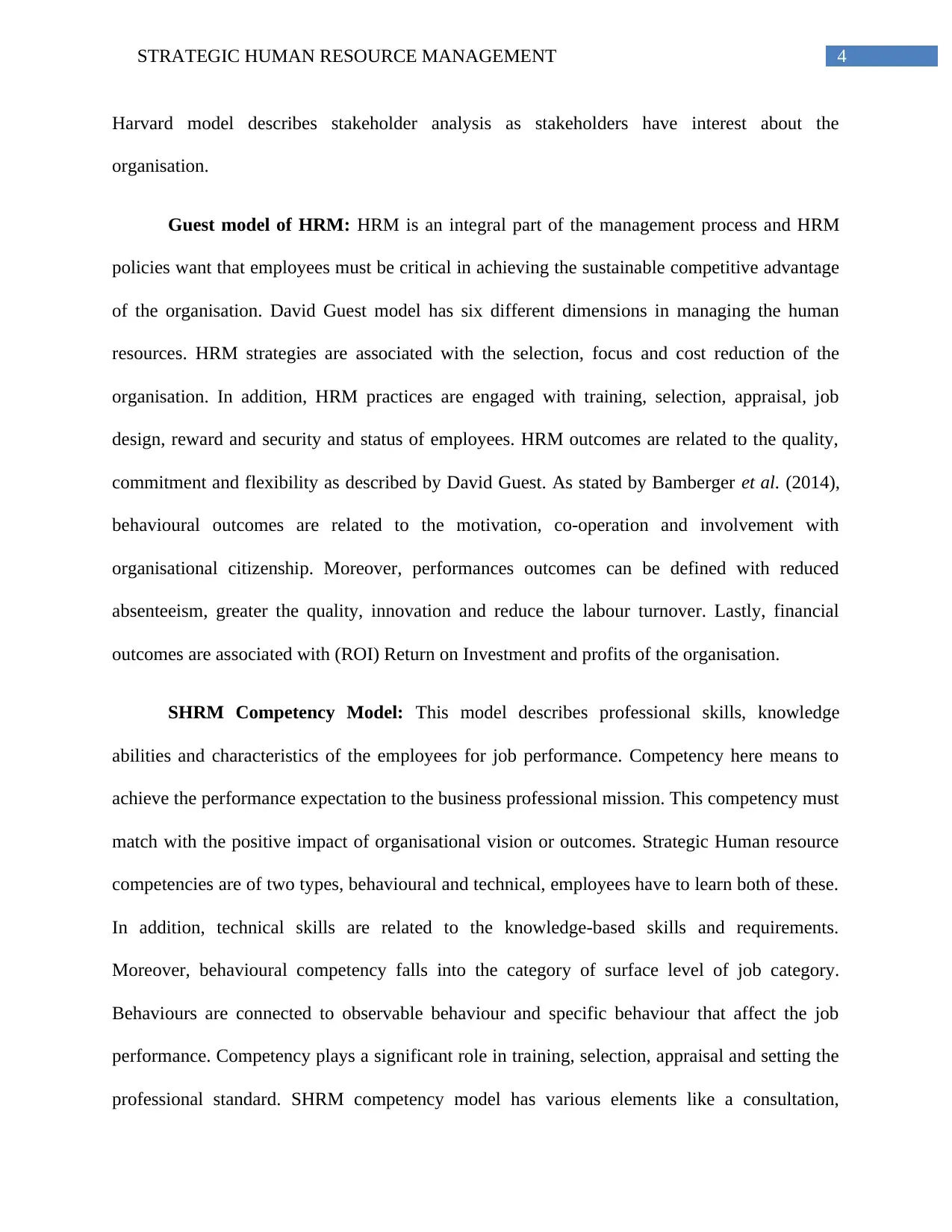
4STRATEGIC HUMAN RESOURCE MANAGEMENT
Harvard model describes stakeholder analysis as stakeholders have interest about the
organisation.
Guest model of HRM: HRM is an integral part of the management process and HRM
policies want that employees must be critical in achieving the sustainable competitive advantage
of the organisation. David Guest model has six different dimensions in managing the human
resources. HRM strategies are associated with the selection, focus and cost reduction of the
organisation. In addition, HRM practices are engaged with training, selection, appraisal, job
design, reward and security and status of employees. HRM outcomes are related to the quality,
commitment and flexibility as described by David Guest. As stated by Bamberger et al. (2014),
behavioural outcomes are related to the motivation, co-operation and involvement with
organisational citizenship. Moreover, performances outcomes can be defined with reduced
absenteeism, greater the quality, innovation and reduce the labour turnover. Lastly, financial
outcomes are associated with (ROI) Return on Investment and profits of the organisation.
SHRM Competency Model: This model describes professional skills, knowledge
abilities and characteristics of the employees for job performance. Competency here means to
achieve the performance expectation to the business professional mission. This competency must
match with the positive impact of organisational vision or outcomes. Strategic Human resource
competencies are of two types, behavioural and technical, employees have to learn both of these.
In addition, technical skills are related to the knowledge-based skills and requirements.
Moreover, behavioural competency falls into the category of surface level of job category.
Behaviours are connected to observable behaviour and specific behaviour that affect the job
performance. Competency plays a significant role in training, selection, appraisal and setting the
professional standard. SHRM competency model has various elements like a consultation,
Harvard model describes stakeholder analysis as stakeholders have interest about the
organisation.
Guest model of HRM: HRM is an integral part of the management process and HRM
policies want that employees must be critical in achieving the sustainable competitive advantage
of the organisation. David Guest model has six different dimensions in managing the human
resources. HRM strategies are associated with the selection, focus and cost reduction of the
organisation. In addition, HRM practices are engaged with training, selection, appraisal, job
design, reward and security and status of employees. HRM outcomes are related to the quality,
commitment and flexibility as described by David Guest. As stated by Bamberger et al. (2014),
behavioural outcomes are related to the motivation, co-operation and involvement with
organisational citizenship. Moreover, performances outcomes can be defined with reduced
absenteeism, greater the quality, innovation and reduce the labour turnover. Lastly, financial
outcomes are associated with (ROI) Return on Investment and profits of the organisation.
SHRM Competency Model: This model describes professional skills, knowledge
abilities and characteristics of the employees for job performance. Competency here means to
achieve the performance expectation to the business professional mission. This competency must
match with the positive impact of organisational vision or outcomes. Strategic Human resource
competencies are of two types, behavioural and technical, employees have to learn both of these.
In addition, technical skills are related to the knowledge-based skills and requirements.
Moreover, behavioural competency falls into the category of surface level of job category.
Behaviours are connected to observable behaviour and specific behaviour that affect the job
performance. Competency plays a significant role in training, selection, appraisal and setting the
professional standard. SHRM competency model has various elements like a consultation,
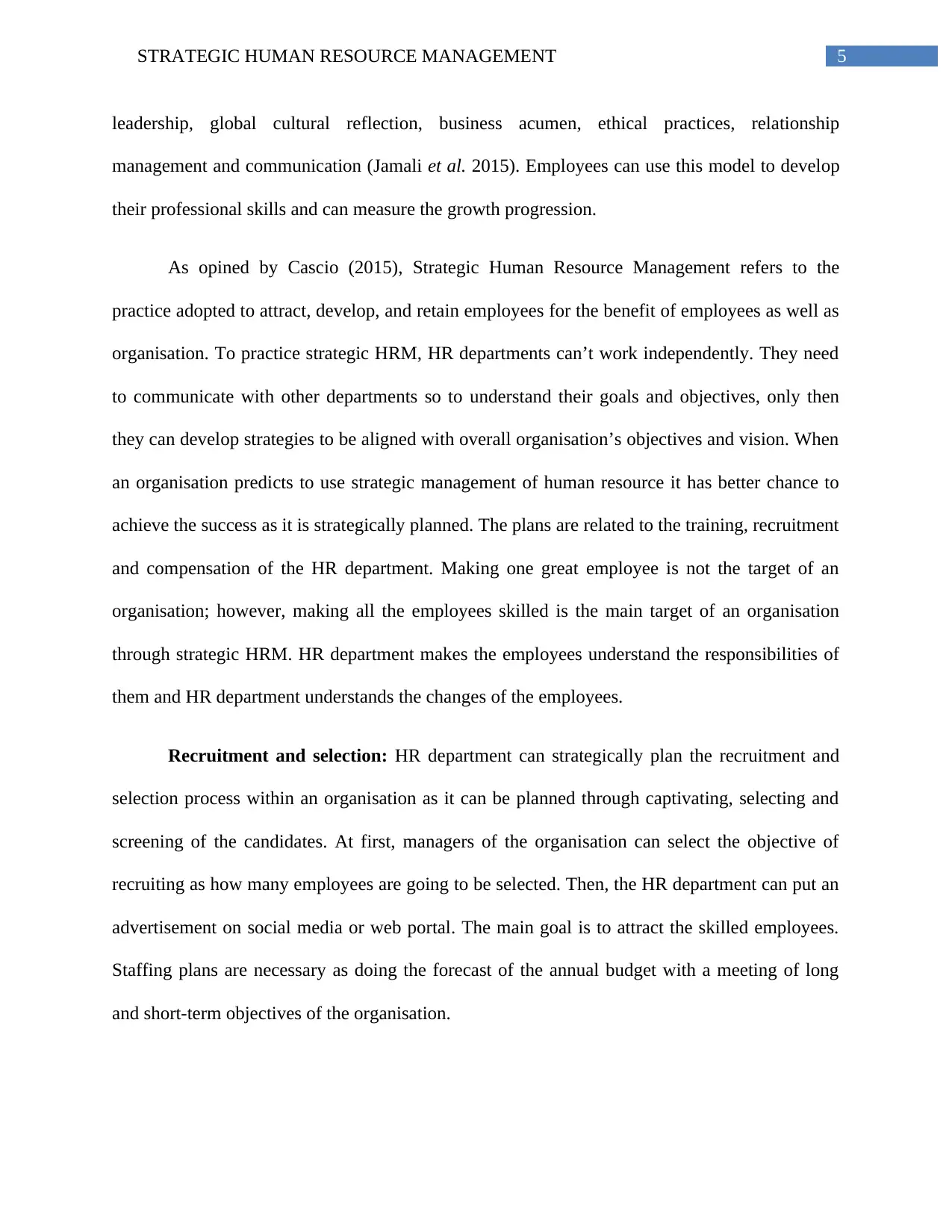
5STRATEGIC HUMAN RESOURCE MANAGEMENT
leadership, global cultural reflection, business acumen, ethical practices, relationship
management and communication (Jamali et al. 2015). Employees can use this model to develop
their professional skills and can measure the growth progression.
As opined by Cascio (2015), Strategic Human Resource Management refers to the
practice adopted to attract, develop, and retain employees for the benefit of employees as well as
organisation. To practice strategic HRM, HR departments can’t work independently. They need
to communicate with other departments so to understand their goals and objectives, only then
they can develop strategies to be aligned with overall organisation’s objectives and vision. When
an organisation predicts to use strategic management of human resource it has better chance to
achieve the success as it is strategically planned. The plans are related to the training, recruitment
and compensation of the HR department. Making one great employee is not the target of an
organisation; however, making all the employees skilled is the main target of an organisation
through strategic HRM. HR department makes the employees understand the responsibilities of
them and HR department understands the changes of the employees.
Recruitment and selection: HR department can strategically plan the recruitment and
selection process within an organisation as it can be planned through captivating, selecting and
screening of the candidates. At first, managers of the organisation can select the objective of
recruiting as how many employees are going to be selected. Then, the HR department can put an
advertisement on social media or web portal. The main goal is to attract the skilled employees.
Staffing plans are necessary as doing the forecast of the annual budget with a meeting of long
and short-term objectives of the organisation.
leadership, global cultural reflection, business acumen, ethical practices, relationship
management and communication (Jamali et al. 2015). Employees can use this model to develop
their professional skills and can measure the growth progression.
As opined by Cascio (2015), Strategic Human Resource Management refers to the
practice adopted to attract, develop, and retain employees for the benefit of employees as well as
organisation. To practice strategic HRM, HR departments can’t work independently. They need
to communicate with other departments so to understand their goals and objectives, only then
they can develop strategies to be aligned with overall organisation’s objectives and vision. When
an organisation predicts to use strategic management of human resource it has better chance to
achieve the success as it is strategically planned. The plans are related to the training, recruitment
and compensation of the HR department. Making one great employee is not the target of an
organisation; however, making all the employees skilled is the main target of an organisation
through strategic HRM. HR department makes the employees understand the responsibilities of
them and HR department understands the changes of the employees.
Recruitment and selection: HR department can strategically plan the recruitment and
selection process within an organisation as it can be planned through captivating, selecting and
screening of the candidates. At first, managers of the organisation can select the objective of
recruiting as how many employees are going to be selected. Then, the HR department can put an
advertisement on social media or web portal. The main goal is to attract the skilled employees.
Staffing plans are necessary as doing the forecast of the annual budget with a meeting of long
and short-term objectives of the organisation.
⊘ This is a preview!⊘
Do you want full access?
Subscribe today to unlock all pages.

Trusted by 1+ million students worldwide
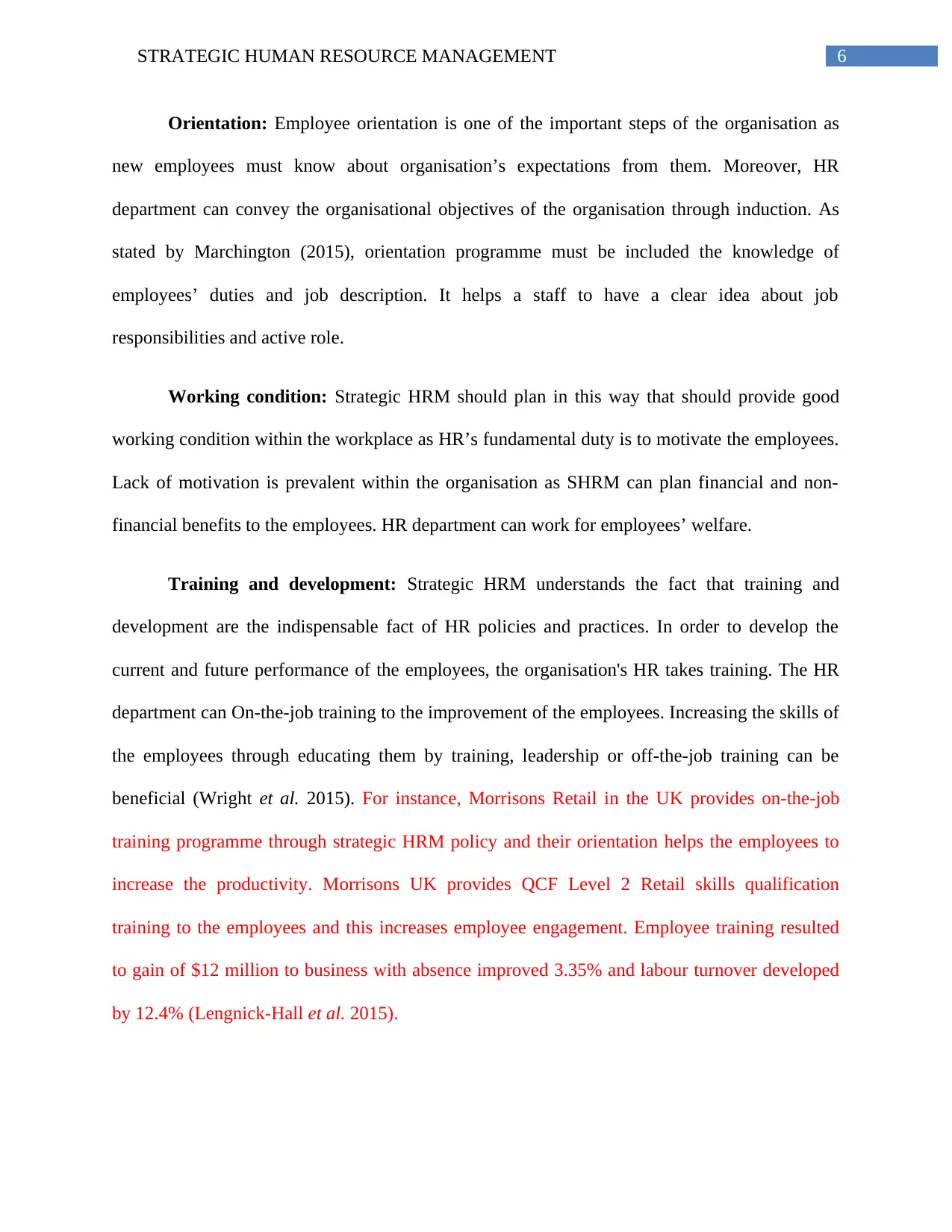
6STRATEGIC HUMAN RESOURCE MANAGEMENT
Orientation: Employee orientation is one of the important steps of the organisation as
new employees must know about organisation’s expectations from them. Moreover, HR
department can convey the organisational objectives of the organisation through induction. As
stated by Marchington (2015), orientation programme must be included the knowledge of
employees’ duties and job description. It helps a staff to have a clear idea about job
responsibilities and active role.
Working condition: Strategic HRM should plan in this way that should provide good
working condition within the workplace as HR’s fundamental duty is to motivate the employees.
Lack of motivation is prevalent within the organisation as SHRM can plan financial and non-
financial benefits to the employees. HR department can work for employees’ welfare.
Training and development: Strategic HRM understands the fact that training and
development are the indispensable fact of HR policies and practices. In order to develop the
current and future performance of the employees, the organisation's HR takes training. The HR
department can On-the-job training to the improvement of the employees. Increasing the skills of
the employees through educating them by training, leadership or off-the-job training can be
beneficial (Wright et al. 2015). For instance, Morrisons Retail in the UK provides on-the-job
training programme through strategic HRM policy and their orientation helps the employees to
increase the productivity. Morrisons UK provides QCF Level 2 Retail skills qualification
training to the employees and this increases employee engagement. Employee training resulted
to gain of $12 million to business with absence improved 3.35% and labour turnover developed
by 12.4% (Lengnick-Hall et al. 2015).
Orientation: Employee orientation is one of the important steps of the organisation as
new employees must know about organisation’s expectations from them. Moreover, HR
department can convey the organisational objectives of the organisation through induction. As
stated by Marchington (2015), orientation programme must be included the knowledge of
employees’ duties and job description. It helps a staff to have a clear idea about job
responsibilities and active role.
Working condition: Strategic HRM should plan in this way that should provide good
working condition within the workplace as HR’s fundamental duty is to motivate the employees.
Lack of motivation is prevalent within the organisation as SHRM can plan financial and non-
financial benefits to the employees. HR department can work for employees’ welfare.
Training and development: Strategic HRM understands the fact that training and
development are the indispensable fact of HR policies and practices. In order to develop the
current and future performance of the employees, the organisation's HR takes training. The HR
department can On-the-job training to the improvement of the employees. Increasing the skills of
the employees through educating them by training, leadership or off-the-job training can be
beneficial (Wright et al. 2015). For instance, Morrisons Retail in the UK provides on-the-job
training programme through strategic HRM policy and their orientation helps the employees to
increase the productivity. Morrisons UK provides QCF Level 2 Retail skills qualification
training to the employees and this increases employee engagement. Employee training resulted
to gain of $12 million to business with absence improved 3.35% and labour turnover developed
by 12.4% (Lengnick-Hall et al. 2015).
Paraphrase This Document
Need a fresh take? Get an instant paraphrase of this document with our AI Paraphraser
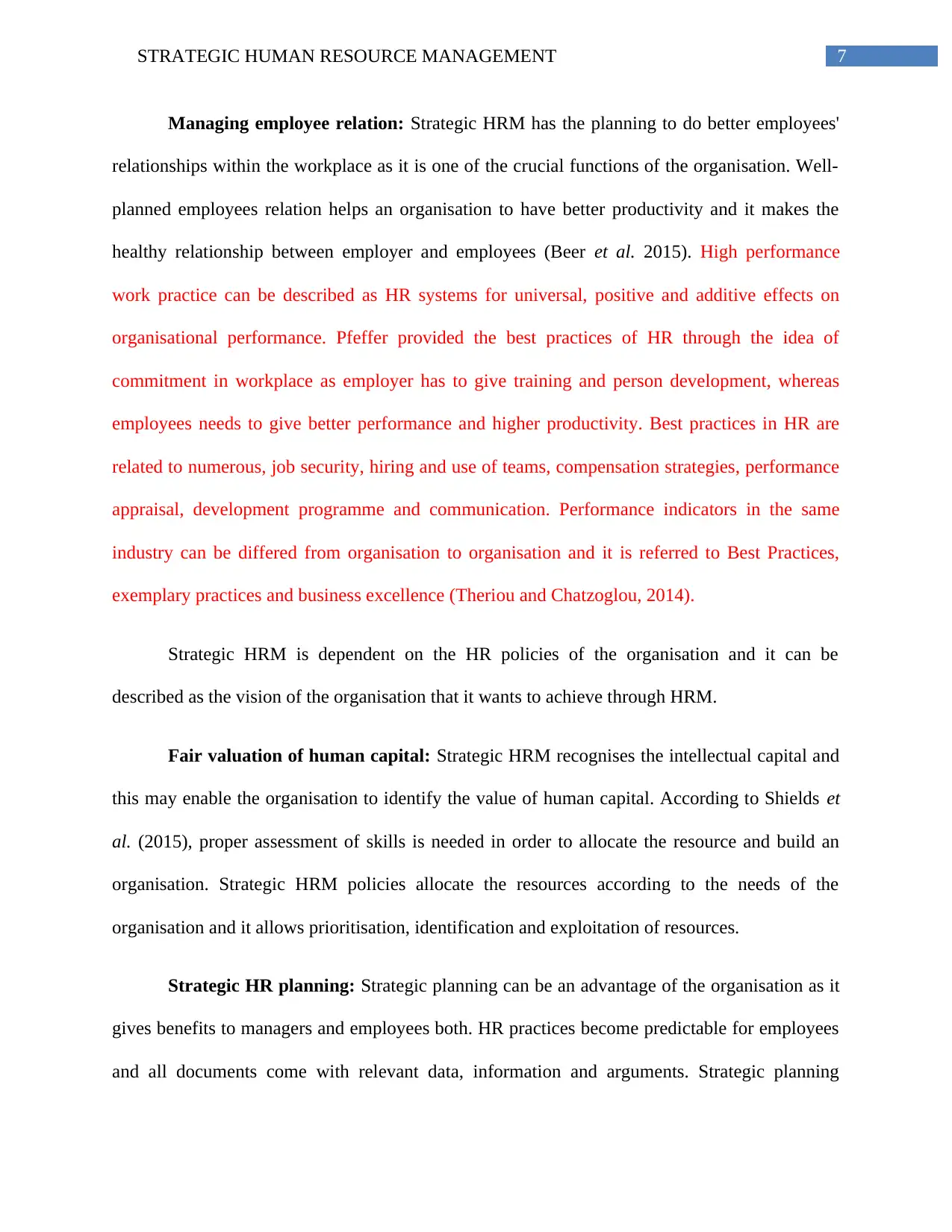
7STRATEGIC HUMAN RESOURCE MANAGEMENT
Managing employee relation: Strategic HRM has the planning to do better employees'
relationships within the workplace as it is one of the crucial functions of the organisation. Well-
planned employees relation helps an organisation to have better productivity and it makes the
healthy relationship between employer and employees (Beer et al. 2015). High performance
work practice can be described as HR systems for universal, positive and additive effects on
organisational performance. Pfeffer provided the best practices of HR through the idea of
commitment in workplace as employer has to give training and person development, whereas
employees needs to give better performance and higher productivity. Best practices in HR are
related to numerous, job security, hiring and use of teams, compensation strategies, performance
appraisal, development programme and communication. Performance indicators in the same
industry can be differed from organisation to organisation and it is referred to Best Practices,
exemplary practices and business excellence (Theriou and Chatzoglou, 2014).
Strategic HRM is dependent on the HR policies of the organisation and it can be
described as the vision of the organisation that it wants to achieve through HRM.
Fair valuation of human capital: Strategic HRM recognises the intellectual capital and
this may enable the organisation to identify the value of human capital. According to Shields et
al. (2015), proper assessment of skills is needed in order to allocate the resource and build an
organisation. Strategic HRM policies allocate the resources according to the needs of the
organisation and it allows prioritisation, identification and exploitation of resources.
Strategic HR planning: Strategic planning can be an advantage of the organisation as it
gives benefits to managers and employees both. HR practices become predictable for employees
and all documents come with relevant data, information and arguments. Strategic planning
Managing employee relation: Strategic HRM has the planning to do better employees'
relationships within the workplace as it is one of the crucial functions of the organisation. Well-
planned employees relation helps an organisation to have better productivity and it makes the
healthy relationship between employer and employees (Beer et al. 2015). High performance
work practice can be described as HR systems for universal, positive and additive effects on
organisational performance. Pfeffer provided the best practices of HR through the idea of
commitment in workplace as employer has to give training and person development, whereas
employees needs to give better performance and higher productivity. Best practices in HR are
related to numerous, job security, hiring and use of teams, compensation strategies, performance
appraisal, development programme and communication. Performance indicators in the same
industry can be differed from organisation to organisation and it is referred to Best Practices,
exemplary practices and business excellence (Theriou and Chatzoglou, 2014).
Strategic HRM is dependent on the HR policies of the organisation and it can be
described as the vision of the organisation that it wants to achieve through HRM.
Fair valuation of human capital: Strategic HRM recognises the intellectual capital and
this may enable the organisation to identify the value of human capital. According to Shields et
al. (2015), proper assessment of skills is needed in order to allocate the resource and build an
organisation. Strategic HRM policies allocate the resources according to the needs of the
organisation and it allows prioritisation, identification and exploitation of resources.
Strategic HR planning: Strategic planning can be an advantage of the organisation as it
gives benefits to managers and employees both. HR practices become predictable for employees
and all documents come with relevant data, information and arguments. Strategic planning
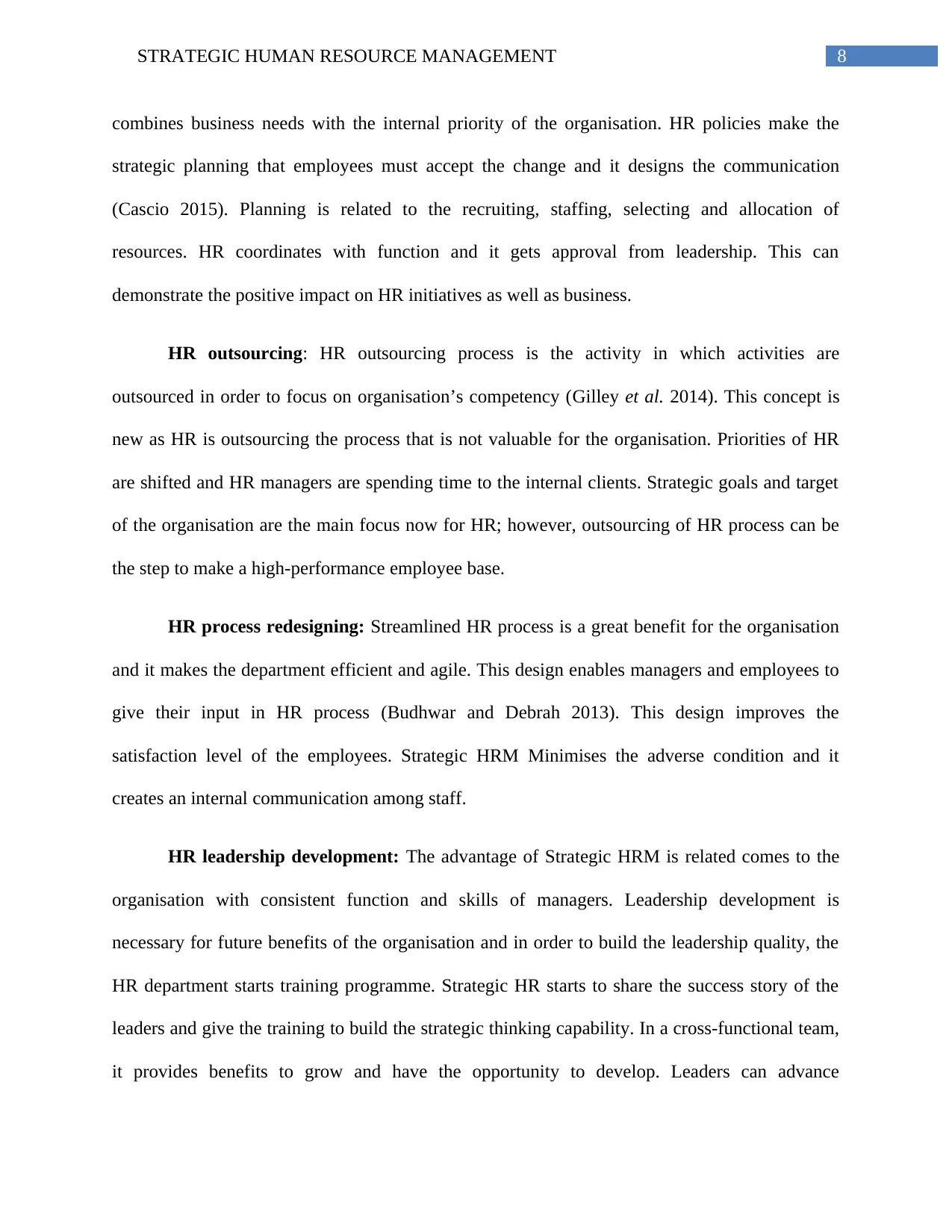
8STRATEGIC HUMAN RESOURCE MANAGEMENT
combines business needs with the internal priority of the organisation. HR policies make the
strategic planning that employees must accept the change and it designs the communication
(Cascio 2015). Planning is related to the recruiting, staffing, selecting and allocation of
resources. HR coordinates with function and it gets approval from leadership. This can
demonstrate the positive impact on HR initiatives as well as business.
HR outsourcing: HR outsourcing process is the activity in which activities are
outsourced in order to focus on organisation’s competency (Gilley et al. 2014). This concept is
new as HR is outsourcing the process that is not valuable for the organisation. Priorities of HR
are shifted and HR managers are spending time to the internal clients. Strategic goals and target
of the organisation are the main focus now for HR; however, outsourcing of HR process can be
the step to make a high-performance employee base.
HR process redesigning: Streamlined HR process is a great benefit for the organisation
and it makes the department efficient and agile. This design enables managers and employees to
give their input in HR process (Budhwar and Debrah 2013). This design improves the
satisfaction level of the employees. Strategic HRM Minimises the adverse condition and it
creates an internal communication among staff.
HR leadership development: The advantage of Strategic HRM is related comes to the
organisation with consistent function and skills of managers. Leadership development is
necessary for future benefits of the organisation and in order to build the leadership quality, the
HR department starts training programme. Strategic HR starts to share the success story of the
leaders and give the training to build the strategic thinking capability. In a cross-functional team,
it provides benefits to grow and have the opportunity to develop. Leaders can advance
combines business needs with the internal priority of the organisation. HR policies make the
strategic planning that employees must accept the change and it designs the communication
(Cascio 2015). Planning is related to the recruiting, staffing, selecting and allocation of
resources. HR coordinates with function and it gets approval from leadership. This can
demonstrate the positive impact on HR initiatives as well as business.
HR outsourcing: HR outsourcing process is the activity in which activities are
outsourced in order to focus on organisation’s competency (Gilley et al. 2014). This concept is
new as HR is outsourcing the process that is not valuable for the organisation. Priorities of HR
are shifted and HR managers are spending time to the internal clients. Strategic goals and target
of the organisation are the main focus now for HR; however, outsourcing of HR process can be
the step to make a high-performance employee base.
HR process redesigning: Streamlined HR process is a great benefit for the organisation
and it makes the department efficient and agile. This design enables managers and employees to
give their input in HR process (Budhwar and Debrah 2013). This design improves the
satisfaction level of the employees. Strategic HRM Minimises the adverse condition and it
creates an internal communication among staff.
HR leadership development: The advantage of Strategic HRM is related comes to the
organisation with consistent function and skills of managers. Leadership development is
necessary for future benefits of the organisation and in order to build the leadership quality, the
HR department starts training programme. Strategic HR starts to share the success story of the
leaders and give the training to build the strategic thinking capability. In a cross-functional team,
it provides benefits to grow and have the opportunity to develop. Leaders can advance
⊘ This is a preview!⊘
Do you want full access?
Subscribe today to unlock all pages.

Trusted by 1+ million students worldwide
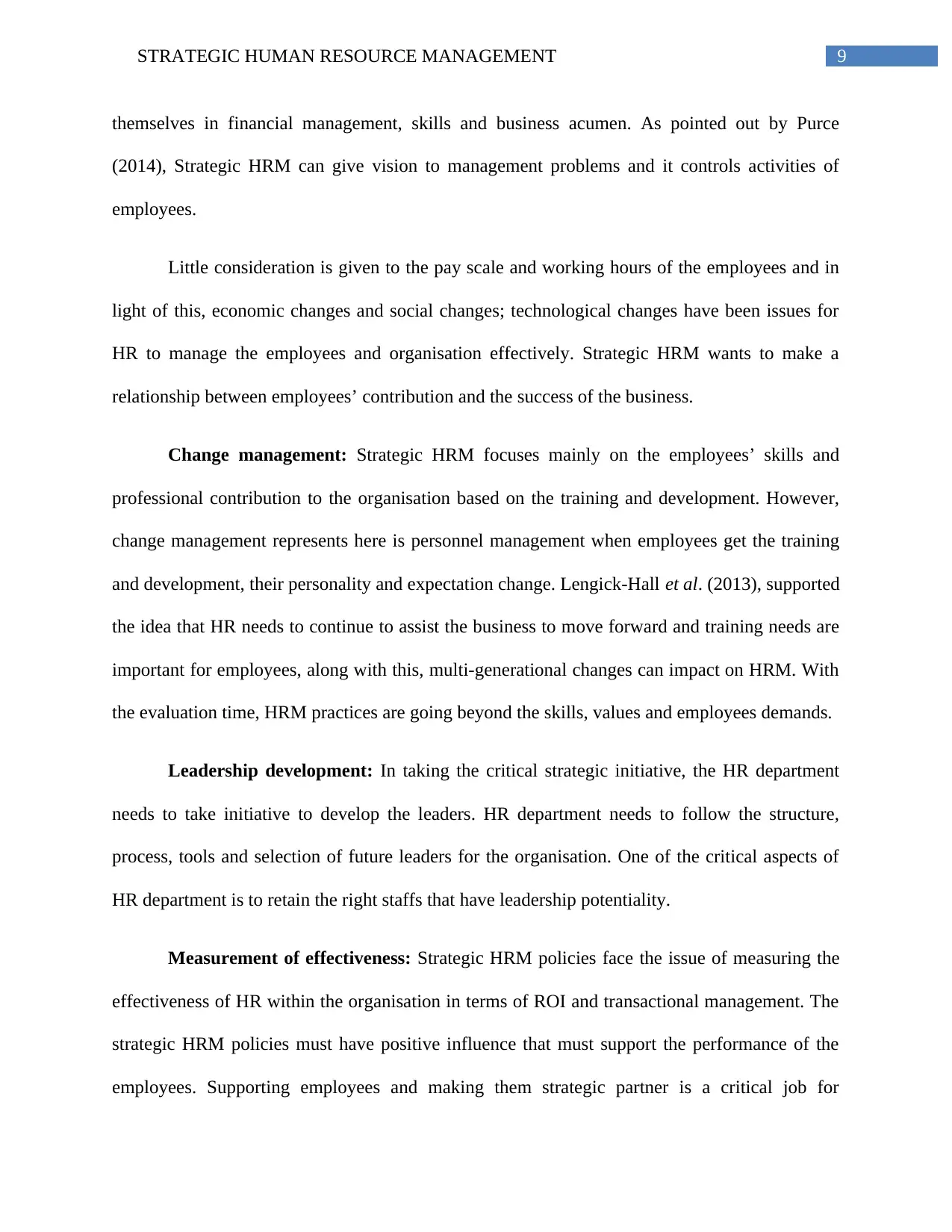
9STRATEGIC HUMAN RESOURCE MANAGEMENT
themselves in financial management, skills and business acumen. As pointed out by Purce
(2014), Strategic HRM can give vision to management problems and it controls activities of
employees.
Little consideration is given to the pay scale and working hours of the employees and in
light of this, economic changes and social changes; technological changes have been issues for
HR to manage the employees and organisation effectively. Strategic HRM wants to make a
relationship between employees’ contribution and the success of the business.
Change management: Strategic HRM focuses mainly on the employees’ skills and
professional contribution to the organisation based on the training and development. However,
change management represents here is personnel management when employees get the training
and development, their personality and expectation change. Lengick-Hall et al. (2013), supported
the idea that HR needs to continue to assist the business to move forward and training needs are
important for employees, along with this, multi-generational changes can impact on HRM. With
the evaluation time, HRM practices are going beyond the skills, values and employees demands.
Leadership development: In taking the critical strategic initiative, the HR department
needs to take initiative to develop the leaders. HR department needs to follow the structure,
process, tools and selection of future leaders for the organisation. One of the critical aspects of
HR department is to retain the right staffs that have leadership potentiality.
Measurement of effectiveness: Strategic HRM policies face the issue of measuring the
effectiveness of HR within the organisation in terms of ROI and transactional management. The
strategic HRM policies must have positive influence that must support the performance of the
employees. Supporting employees and making them strategic partner is a critical job for
themselves in financial management, skills and business acumen. As pointed out by Purce
(2014), Strategic HRM can give vision to management problems and it controls activities of
employees.
Little consideration is given to the pay scale and working hours of the employees and in
light of this, economic changes and social changes; technological changes have been issues for
HR to manage the employees and organisation effectively. Strategic HRM wants to make a
relationship between employees’ contribution and the success of the business.
Change management: Strategic HRM focuses mainly on the employees’ skills and
professional contribution to the organisation based on the training and development. However,
change management represents here is personnel management when employees get the training
and development, their personality and expectation change. Lengick-Hall et al. (2013), supported
the idea that HR needs to continue to assist the business to move forward and training needs are
important for employees, along with this, multi-generational changes can impact on HRM. With
the evaluation time, HRM practices are going beyond the skills, values and employees demands.
Leadership development: In taking the critical strategic initiative, the HR department
needs to take initiative to develop the leaders. HR department needs to follow the structure,
process, tools and selection of future leaders for the organisation. One of the critical aspects of
HR department is to retain the right staffs that have leadership potentiality.
Measurement of effectiveness: Strategic HRM policies face the issue of measuring the
effectiveness of HR within the organisation in terms of ROI and transactional management. The
strategic HRM policies must have positive influence that must support the performance of the
employees. Supporting employees and making them strategic partner is a critical job for
Paraphrase This Document
Need a fresh take? Get an instant paraphrase of this document with our AI Paraphraser
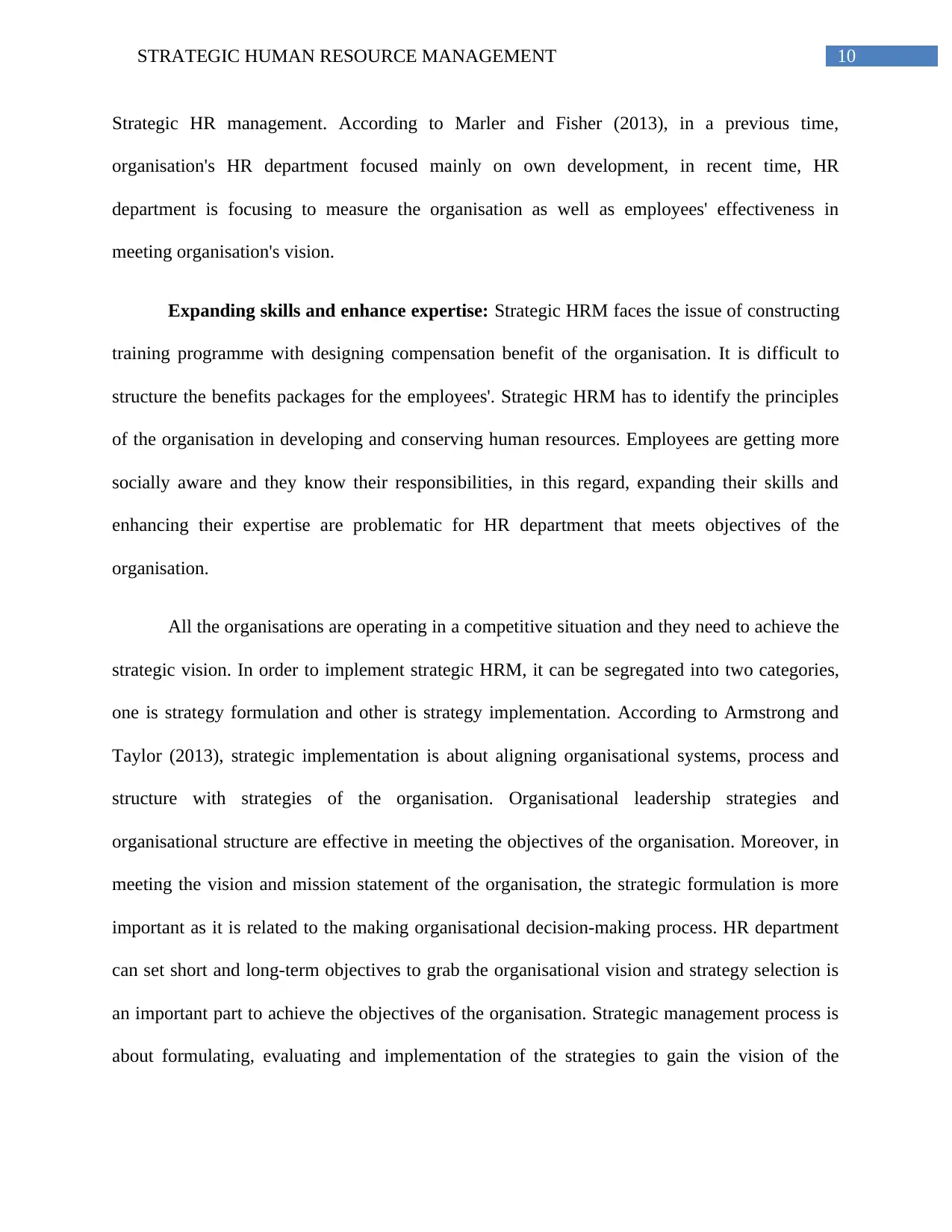
10STRATEGIC HUMAN RESOURCE MANAGEMENT
Strategic HR management. According to Marler and Fisher (2013), in a previous time,
organisation's HR department focused mainly on own development, in recent time, HR
department is focusing to measure the organisation as well as employees' effectiveness in
meeting organisation's vision.
Expanding skills and enhance expertise: Strategic HRM faces the issue of constructing
training programme with designing compensation benefit of the organisation. It is difficult to
structure the benefits packages for the employees'. Strategic HRM has to identify the principles
of the organisation in developing and conserving human resources. Employees are getting more
socially aware and they know their responsibilities, in this regard, expanding their skills and
enhancing their expertise are problematic for HR department that meets objectives of the
organisation.
All the organisations are operating in a competitive situation and they need to achieve the
strategic vision. In order to implement strategic HRM, it can be segregated into two categories,
one is strategy formulation and other is strategy implementation. According to Armstrong and
Taylor (2013), strategic implementation is about aligning organisational systems, process and
structure with strategies of the organisation. Organisational leadership strategies and
organisational structure are effective in meeting the objectives of the organisation. Moreover, in
meeting the vision and mission statement of the organisation, the strategic formulation is more
important as it is related to the making organisational decision-making process. HR department
can set short and long-term objectives to grab the organisational vision and strategy selection is
an important part to achieve the objectives of the organisation. Strategic management process is
about formulating, evaluating and implementation of the strategies to gain the vision of the
Strategic HR management. According to Marler and Fisher (2013), in a previous time,
organisation's HR department focused mainly on own development, in recent time, HR
department is focusing to measure the organisation as well as employees' effectiveness in
meeting organisation's vision.
Expanding skills and enhance expertise: Strategic HRM faces the issue of constructing
training programme with designing compensation benefit of the organisation. It is difficult to
structure the benefits packages for the employees'. Strategic HRM has to identify the principles
of the organisation in developing and conserving human resources. Employees are getting more
socially aware and they know their responsibilities, in this regard, expanding their skills and
enhancing their expertise are problematic for HR department that meets objectives of the
organisation.
All the organisations are operating in a competitive situation and they need to achieve the
strategic vision. In order to implement strategic HRM, it can be segregated into two categories,
one is strategy formulation and other is strategy implementation. According to Armstrong and
Taylor (2013), strategic implementation is about aligning organisational systems, process and
structure with strategies of the organisation. Organisational leadership strategies and
organisational structure are effective in meeting the objectives of the organisation. Moreover, in
meeting the vision and mission statement of the organisation, the strategic formulation is more
important as it is related to the making organisational decision-making process. HR department
can set short and long-term objectives to grab the organisational vision and strategy selection is
an important part to achieve the objectives of the organisation. Strategic management process is
about formulating, evaluating and implementation of the strategies to gain the vision of the
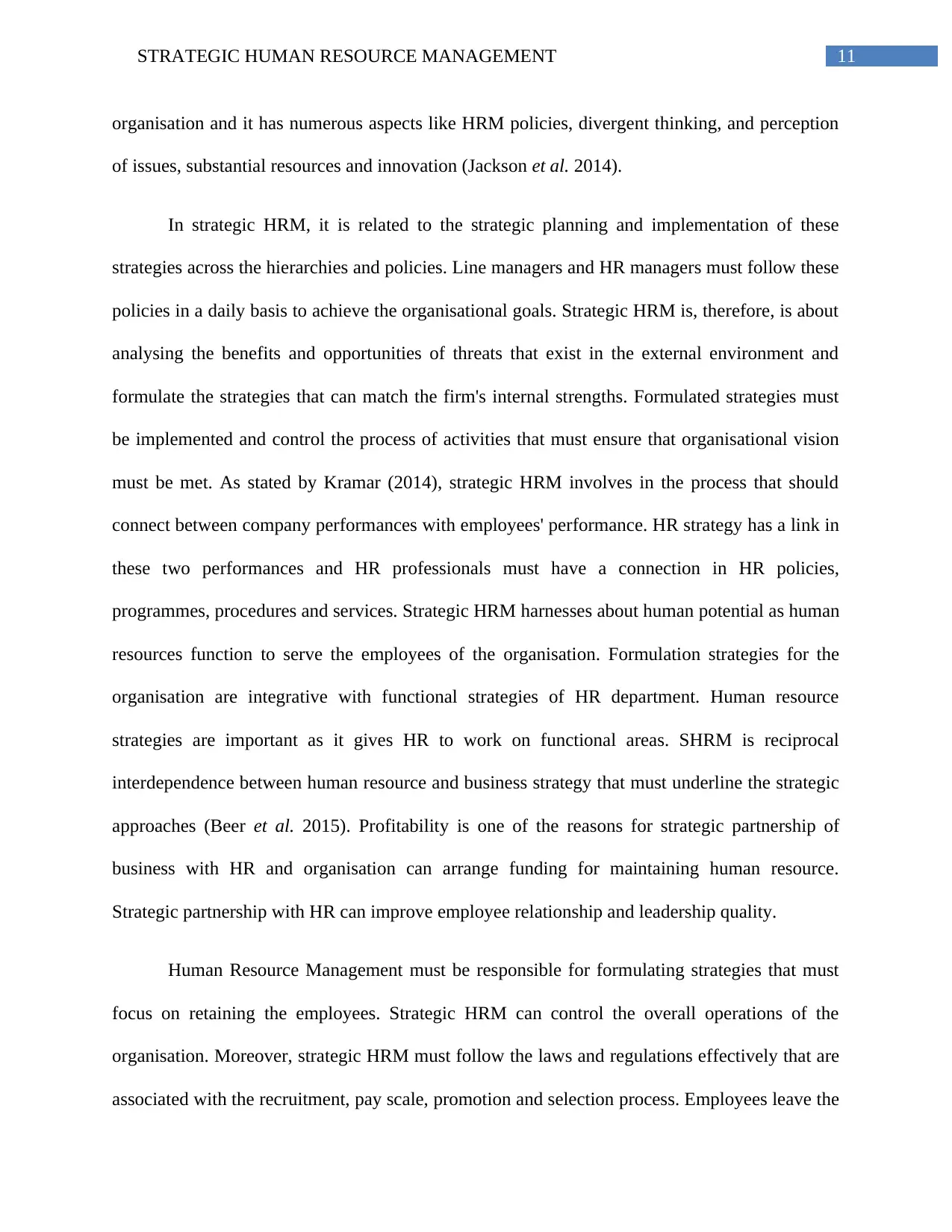
11STRATEGIC HUMAN RESOURCE MANAGEMENT
organisation and it has numerous aspects like HRM policies, divergent thinking, and perception
of issues, substantial resources and innovation (Jackson et al. 2014).
In strategic HRM, it is related to the strategic planning and implementation of these
strategies across the hierarchies and policies. Line managers and HR managers must follow these
policies in a daily basis to achieve the organisational goals. Strategic HRM is, therefore, is about
analysing the benefits and opportunities of threats that exist in the external environment and
formulate the strategies that can match the firm's internal strengths. Formulated strategies must
be implemented and control the process of activities that must ensure that organisational vision
must be met. As stated by Kramar (2014), strategic HRM involves in the process that should
connect between company performances with employees' performance. HR strategy has a link in
these two performances and HR professionals must have a connection in HR policies,
programmes, procedures and services. Strategic HRM harnesses about human potential as human
resources function to serve the employees of the organisation. Formulation strategies for the
organisation are integrative with functional strategies of HR department. Human resource
strategies are important as it gives HR to work on functional areas. SHRM is reciprocal
interdependence between human resource and business strategy that must underline the strategic
approaches (Beer et al. 2015). Profitability is one of the reasons for strategic partnership of
business with HR and organisation can arrange funding for maintaining human resource.
Strategic partnership with HR can improve employee relationship and leadership quality.
Human Resource Management must be responsible for formulating strategies that must
focus on retaining the employees. Strategic HRM can control the overall operations of the
organisation. Moreover, strategic HRM must follow the laws and regulations effectively that are
associated with the recruitment, pay scale, promotion and selection process. Employees leave the
organisation and it has numerous aspects like HRM policies, divergent thinking, and perception
of issues, substantial resources and innovation (Jackson et al. 2014).
In strategic HRM, it is related to the strategic planning and implementation of these
strategies across the hierarchies and policies. Line managers and HR managers must follow these
policies in a daily basis to achieve the organisational goals. Strategic HRM is, therefore, is about
analysing the benefits and opportunities of threats that exist in the external environment and
formulate the strategies that can match the firm's internal strengths. Formulated strategies must
be implemented and control the process of activities that must ensure that organisational vision
must be met. As stated by Kramar (2014), strategic HRM involves in the process that should
connect between company performances with employees' performance. HR strategy has a link in
these two performances and HR professionals must have a connection in HR policies,
programmes, procedures and services. Strategic HRM harnesses about human potential as human
resources function to serve the employees of the organisation. Formulation strategies for the
organisation are integrative with functional strategies of HR department. Human resource
strategies are important as it gives HR to work on functional areas. SHRM is reciprocal
interdependence between human resource and business strategy that must underline the strategic
approaches (Beer et al. 2015). Profitability is one of the reasons for strategic partnership of
business with HR and organisation can arrange funding for maintaining human resource.
Strategic partnership with HR can improve employee relationship and leadership quality.
Human Resource Management must be responsible for formulating strategies that must
focus on retaining the employees. Strategic HRM can control the overall operations of the
organisation. Moreover, strategic HRM must follow the laws and regulations effectively that are
associated with the recruitment, pay scale, promotion and selection process. Employees leave the
⊘ This is a preview!⊘
Do you want full access?
Subscribe today to unlock all pages.

Trusted by 1+ million students worldwide
1 out of 16
Related Documents
Your All-in-One AI-Powered Toolkit for Academic Success.
+13062052269
info@desklib.com
Available 24*7 on WhatsApp / Email
![[object Object]](/_next/static/media/star-bottom.7253800d.svg)
Unlock your academic potential
Copyright © 2020–2025 A2Z Services. All Rights Reserved. Developed and managed by ZUCOL.





